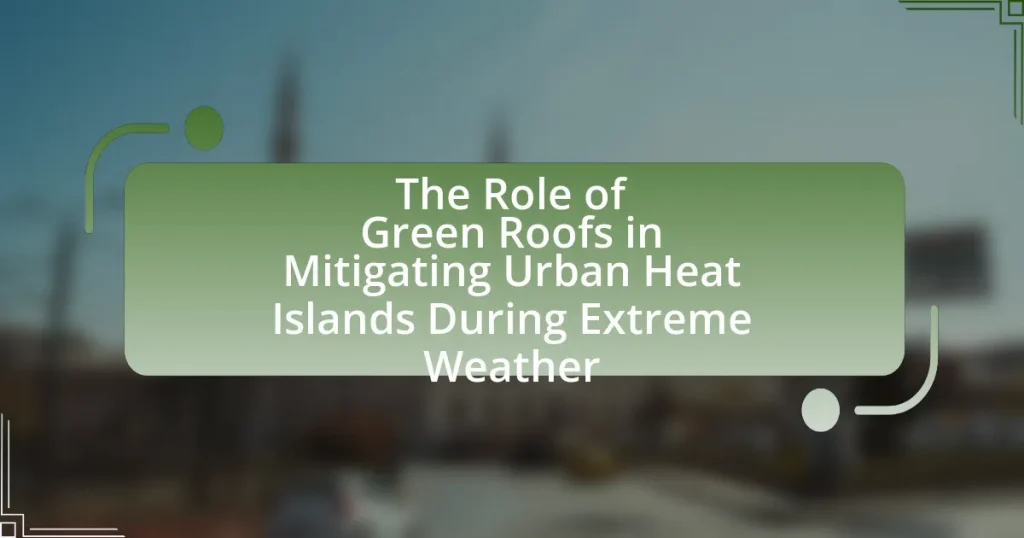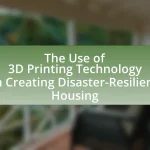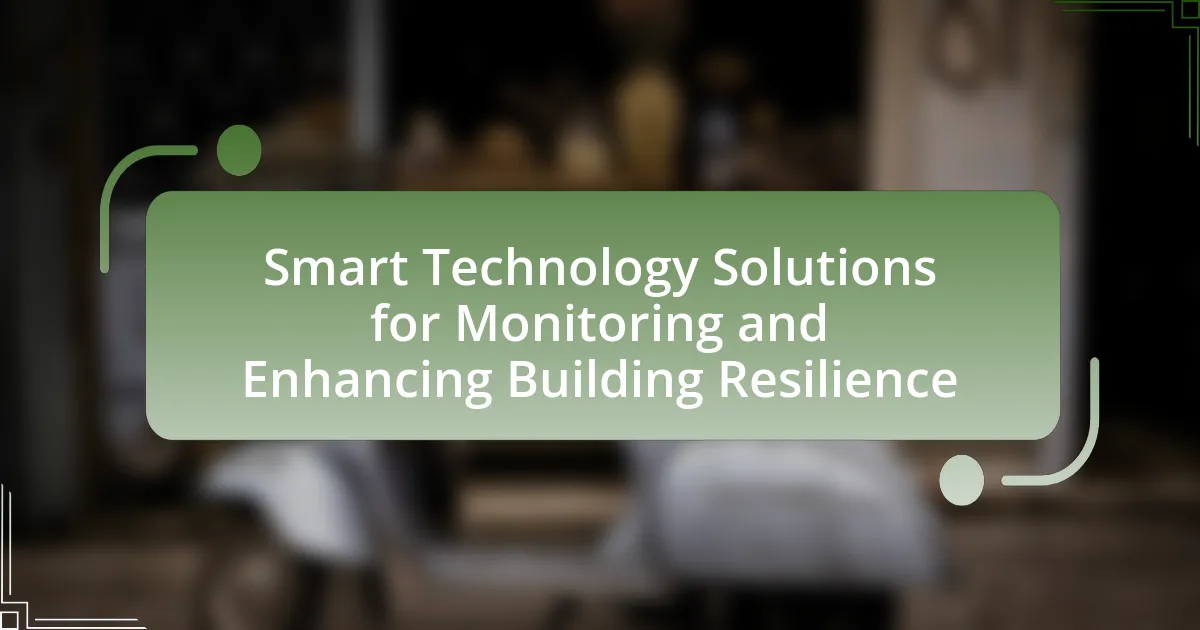Green roofs are vegetated systems installed on building rooftops that provide significant environmental benefits, particularly in urban areas. They play a crucial role in mitigating urban heat islands by reducing heat absorption, improving air quality, managing stormwater runoff, and enhancing biodiversity. The article explores how green roofs function to lower surface temperatures, the materials used in their construction, and their effectiveness in combating extreme weather impacts. Additionally, it addresses the challenges of implementing green roofs, including economic factors, maintenance practices, and best design features for resilience against climate change.
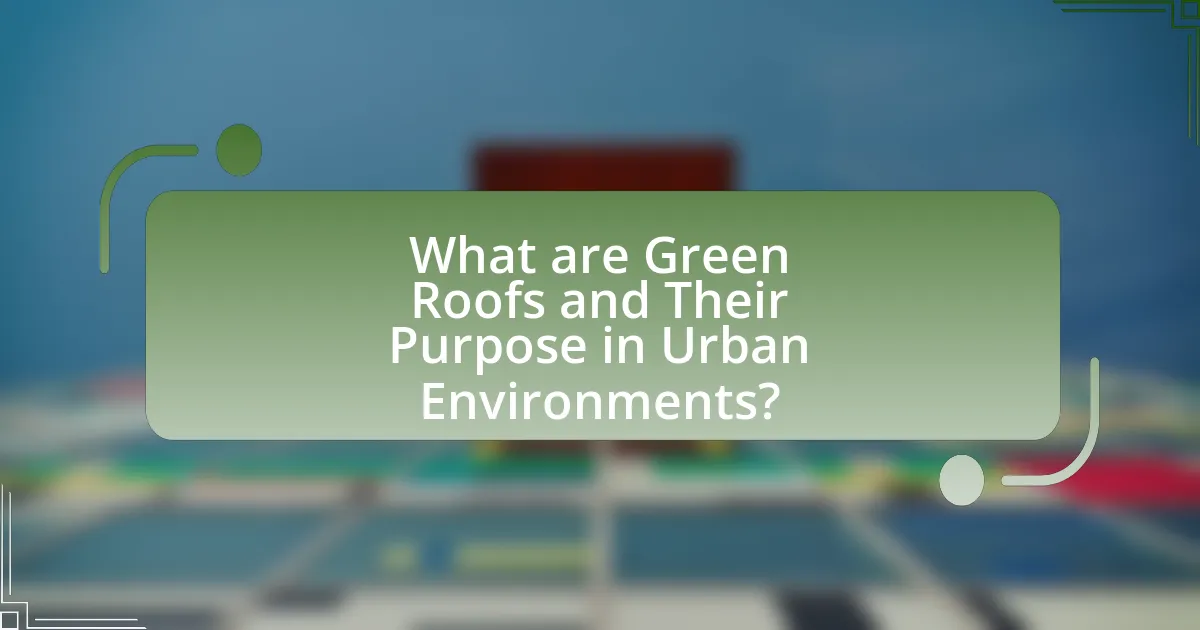
What are Green Roofs and Their Purpose in Urban Environments?
Green roofs are vegetated systems installed on building rooftops that support plant growth and provide various environmental benefits. Their primary purpose in urban environments includes reducing heat absorption, improving air quality, managing stormwater runoff, and enhancing biodiversity. Studies indicate that green roofs can lower surface temperatures by up to 40% compared to conventional roofs, thereby mitigating the urban heat island effect, which is particularly critical during extreme weather events. Additionally, they contribute to energy savings by insulating buildings, reducing the need for air conditioning, and promoting urban resilience against climate change.
How do Green Roofs function to mitigate urban heat?
Green roofs mitigate urban heat by providing insulation and reducing heat absorption through vegetation and soil layers. The plants on green roofs absorb sunlight, which lowers surface temperatures compared to conventional roofs, while the soil retains moisture, promoting evaporative cooling. Studies indicate that green roofs can reduce ambient temperatures by up to 5 degrees Celsius in urban areas, significantly alleviating the urban heat island effect.
What materials are typically used in the construction of Green Roofs?
Green roofs are typically constructed using a combination of waterproof membranes, drainage layers, growing media, and vegetation. The waterproof membrane serves as a barrier to prevent water from penetrating the building, while the drainage layer facilitates excess water flow and prevents waterlogging. The growing media, which is a lightweight soil mix, supports plant growth and retains moisture. Finally, the vegetation, which can include a variety of plants such as sedums, grasses, and wildflowers, provides the green cover essential for the roof’s ecological benefits. These materials work together to enhance the roof’s functionality, contributing to urban heat island mitigation by providing insulation and reducing surface temperatures.
How do the layers of a Green Roof contribute to temperature regulation?
The layers of a Green Roof contribute to temperature regulation by providing insulation, reducing heat absorption, and enhancing evapotranspiration. The substrate layer retains moisture, which cools the air through evaporation, while the vegetation layer provides shade and further reduces surface temperatures. Studies indicate that Green Roofs can lower rooftop temperatures by up to 40% compared to conventional roofs, significantly mitigating the urban heat island effect. This temperature regulation is crucial during extreme weather events, as it helps maintain cooler microclimates in urban areas.
Why are Urban Heat Islands a Concern in Extreme Weather?
Urban Heat Islands (UHIs) are a concern in extreme weather because they exacerbate heat-related health risks and increase energy demand. During extreme heat events, urban areas can experience temperatures that are significantly higher than surrounding rural areas, sometimes by as much as 5 to 10 degrees Fahrenheit. This temperature differential can lead to higher incidences of heat-related illnesses and fatalities, particularly among vulnerable populations such as the elderly and those with pre-existing health conditions. Additionally, the increased temperatures drive up energy consumption for cooling, which can strain power grids and lead to outages. Studies have shown that cities with pronounced UHIs face greater challenges during heat waves, highlighting the need for effective mitigation strategies like green roofs to reduce these temperature disparities.
What factors contribute to the formation of Urban Heat Islands?
Urban Heat Islands are primarily formed due to factors such as increased surface area of buildings, reduced vegetation, and heat generated from human activities. Urban areas typically have more concrete and asphalt, which absorb and retain heat, leading to higher temperatures compared to surrounding rural areas. The lack of vegetation diminishes natural cooling processes, while activities like transportation and industrial processes contribute additional heat. Studies indicate that urban areas can be 2 to 5 degrees Fahrenheit warmer than their rural counterparts, highlighting the significant impact of these factors on local climates.
How do Urban Heat Islands impact public health and the environment?
Urban Heat Islands (UHIs) negatively impact public health and the environment by increasing temperatures in urban areas compared to their rural surroundings. This temperature elevation can lead to heat-related illnesses, such as heat exhaustion and heat stroke, particularly affecting vulnerable populations like the elderly and those with pre-existing health conditions. Research indicates that urban areas can be 1 to 7 degrees Fahrenheit warmer than rural areas, exacerbating air pollution and increasing energy consumption for cooling, which further contributes to greenhouse gas emissions. Additionally, UHIs can worsen water quality by raising the temperature of stormwater runoff, leading to harmful algal blooms in nearby water bodies.
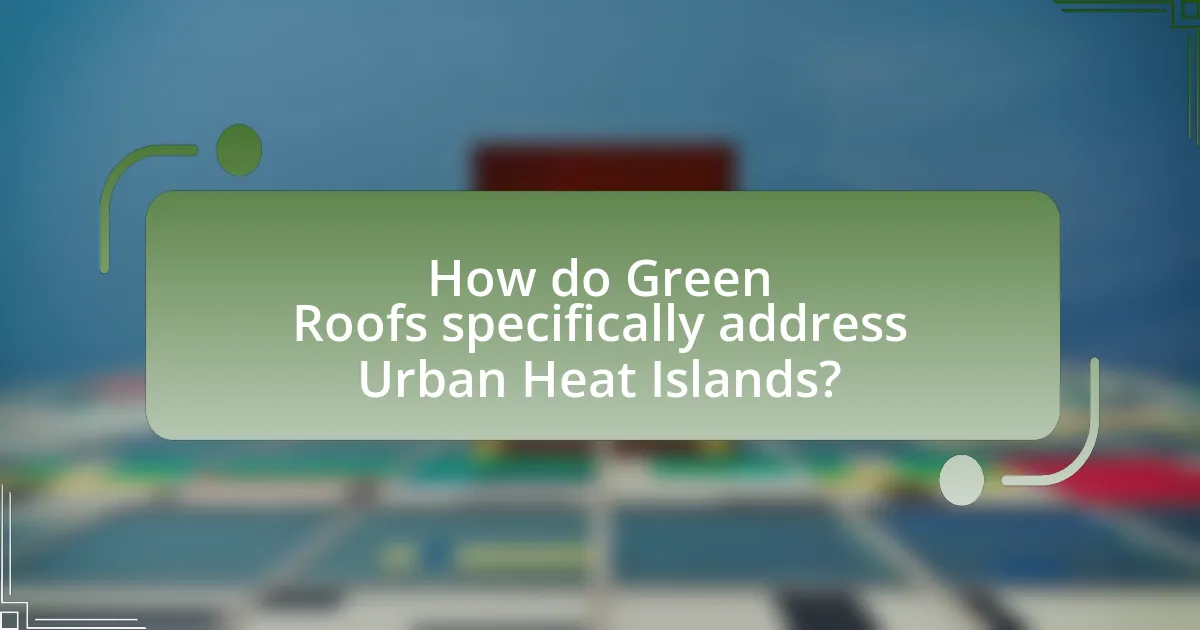
How do Green Roofs specifically address Urban Heat Islands?
Green roofs specifically address Urban Heat Islands by providing vegetation that cools the surrounding environment through evapotranspiration and shading. This cooling effect reduces surface and air temperatures in urban areas, which are typically elevated due to heat-absorbing materials like asphalt and concrete. Studies indicate that green roofs can lower rooftop temperatures by 30-40% compared to conventional roofs, significantly mitigating the heat island effect. Additionally, a report by the U.S. Environmental Protection Agency highlights that urban areas with extensive green roofs can experience temperature reductions of up to 5°F, demonstrating their effectiveness in combating urban heat islands.
What mechanisms do Green Roofs use to reduce heat absorption in cities?
Green roofs reduce heat absorption in cities primarily through vegetation, soil, and water retention. The plants on green roofs provide shade, which lowers surface temperatures, while the soil acts as an insulating layer that mitigates heat transfer. Additionally, the moisture in the soil and plants facilitates evaporative cooling, further decreasing ambient temperatures. Research indicates that green roofs can lower rooftop temperatures by up to 40% compared to conventional roofs, significantly contributing to urban heat island mitigation.
How does vegetation on Green Roofs influence local microclimates?
Vegetation on green roofs significantly influences local microclimates by reducing ambient temperatures and improving air quality. The plants absorb sunlight and provide shade, which lowers surface temperatures and mitigates the urban heat island effect. Research indicates that green roofs can reduce rooftop temperatures by up to 40% compared to conventional roofs, leading to cooler surrounding air temperatures. Additionally, the evapotranspiration process of vegetation releases moisture into the air, further cooling the microclimate. Studies have shown that areas with green roofs can experience temperature reductions of 2 to 5 degrees Celsius during peak heat periods, demonstrating their effectiveness in enhancing local climate conditions.
What role does evapotranspiration play in cooling urban areas?
Evapotranspiration plays a crucial role in cooling urban areas by facilitating the transfer of moisture from the soil and plants into the atmosphere, which helps to lower ambient temperatures. This process occurs when water evaporates from surfaces and transpires from plant leaves, effectively removing heat from the environment. Studies have shown that urban areas with increased vegetation, such as green roofs, can experience temperature reductions of up to 5 degrees Celsius compared to areas with minimal greenery. This cooling effect is particularly significant during extreme weather events, where urban heat islands can exacerbate heat stress and energy consumption.
What evidence supports the effectiveness of Green Roofs in heat mitigation?
Green roofs effectively mitigate heat by reducing surface and ambient temperatures in urban areas. Studies, such as the one conducted by the National Research Council of Canada, demonstrate that green roofs can lower rooftop temperatures by up to 40% compared to conventional roofs. Additionally, research published in the journal “Environmental Science & Technology” indicates that green roofs can reduce the urban heat island effect by cooling surrounding air temperatures by 1 to 2 degrees Celsius. These findings are supported by empirical data showing that vegetation on roofs provides insulation, absorbs sunlight, and facilitates evapotranspiration, all contributing to lower heat levels in urban environments.
What studies have been conducted on the temperature differences between Green Roofs and traditional roofs?
Numerous studies have been conducted to analyze the temperature differences between green roofs and traditional roofs. For instance, a study by Getter and Rowe (2006) published in the journal “Environmental Science & Technology” found that green roofs can reduce surface temperatures by up to 30% compared to conventional roofs, particularly during peak summer months. Another significant study by Wong et al. (2003) in “Building and Environment” reported that green roofs maintained lower temperatures, with differences reaching 5 to 10 degrees Celsius compared to traditional roofs. These findings consistently demonstrate that green roofs effectively mitigate heat absorption, contributing to lower urban temperatures and alleviating the urban heat island effect.
How do Green Roofs compare to other urban heat mitigation strategies?
Green roofs are highly effective urban heat mitigation strategies, often outperforming traditional methods such as reflective surfaces and shade trees. Research indicates that green roofs can reduce surface temperatures by up to 40% compared to conventional roofs, significantly lowering the urban heat island effect. Additionally, a study published in the journal “Environmental Science & Technology” by Getter and Rowe (2006) found that green roofs not only provide insulation but also improve air quality and manage stormwater, benefits that other strategies may not offer to the same extent. In contrast, reflective surfaces primarily address heat absorption but do not contribute to biodiversity or stormwater management, while shade trees require space and time to mature. Thus, green roofs present a multifaceted approach to mitigating urban heat, combining temperature reduction with ecological benefits.
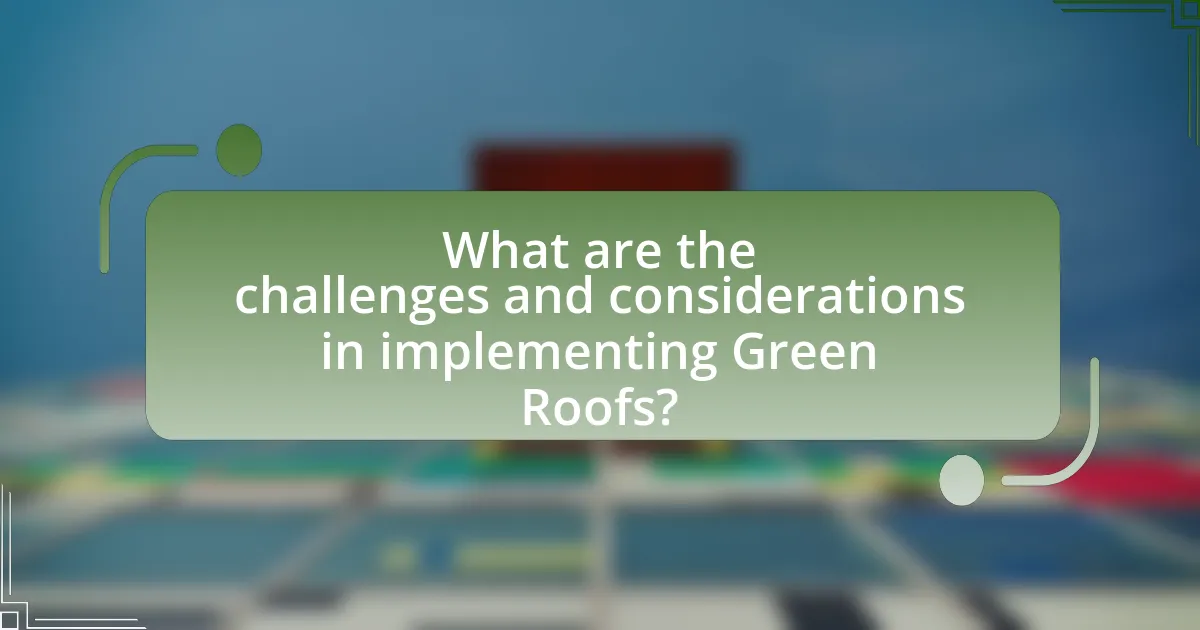
What are the challenges and considerations in implementing Green Roofs?
Implementing green roofs presents several challenges and considerations, including structural load capacity, plant selection, maintenance requirements, and initial costs. Structural load capacity must be assessed to ensure that the building can support the additional weight of soil and vegetation, which can exceed 100 pounds per square foot when saturated. Plant selection is critical, as the chosen species must be drought-resistant and suitable for the local climate to thrive with minimal maintenance. Maintenance requirements can be significant, as green roofs need regular care to manage plant health and prevent issues like weed growth and drainage problems. Initial costs can be high, often ranging from $10 to $25 per square foot, which may deter some property owners despite long-term benefits such as energy savings and stormwater management.
What are the economic factors influencing the adoption of Green Roofs?
The economic factors influencing the adoption of green roofs include initial installation costs, long-term savings on energy and maintenance, and potential increases in property value. Initial installation costs can be high, often ranging from $10 to $25 per square foot, which can deter some property owners. However, studies show that green roofs can reduce energy costs by up to 25% by providing insulation, leading to significant savings over time. Additionally, properties with green roofs often see an increase in value, with some estimates suggesting a rise of 5% to 15% in property prices due to enhanced aesthetics and environmental benefits. Furthermore, government incentives and grants can offset initial costs, making green roofs more financially viable for developers and homeowners.
How do initial installation costs compare to long-term savings?
Initial installation costs for green roofs are typically higher than traditional roofing options, often ranging from $10 to $25 per square foot. However, long-term savings can be substantial, with studies indicating that green roofs can reduce energy costs by up to 25% due to improved insulation and reduced heat absorption. Additionally, they can extend the lifespan of the roof by 20 years or more, leading to lower replacement costs. The environmental benefits, such as stormwater management and reduced urban heat, further enhance their value, making the initial investment financially advantageous over time.
What funding or incentives are available for Green Roof projects?
Various funding and incentives are available for Green Roof projects, including federal grants, state tax credits, and local government rebates. For instance, the U.S. Environmental Protection Agency offers grants through programs like the Green Infrastructure Grant Program, which supports projects that incorporate green roofs to manage stormwater. Additionally, many states provide tax incentives, such as New York’s Green Roof Tax Abatement, which offers property tax reductions for installing green roofs. Local municipalities often have rebate programs to encourage green infrastructure, further promoting the adoption of green roofs as a means to mitigate urban heat islands during extreme weather.
What maintenance practices are essential for effective Green Roofs?
Essential maintenance practices for effective green roofs include regular inspections, irrigation management, weed control, and plant health monitoring. Regular inspections help identify issues such as drainage problems or plant diseases early, ensuring the longevity and functionality of the green roof. Irrigation management is crucial, as green roofs require adequate moisture, especially during dry periods, to maintain plant health and prevent stress. Weed control is necessary to prevent invasive species from outcompeting desired plants, which can disrupt the ecosystem and aesthetic of the green roof. Additionally, monitoring plant health allows for timely interventions, such as fertilization or pest control, to sustain the green roof’s biodiversity and effectiveness in mitigating urban heat islands. These practices collectively contribute to the resilience and performance of green roofs in urban environments.
How often should Green Roofs be inspected and maintained?
Green roofs should be inspected and maintained at least twice a year, ideally in the spring and fall. Regular inspections help identify issues such as plant health, drainage problems, and structural integrity, which are crucial for the roof’s performance and longevity. Research indicates that proactive maintenance can extend the lifespan of green roofs and enhance their effectiveness in mitigating urban heat islands, as healthy vegetation contributes to cooling effects.
What common issues can arise with Green Roofs, and how can they be addressed?
Common issues that can arise with green roofs include water retention problems, structural load concerns, and plant maintenance challenges. Water retention issues can lead to excessive moisture, which may cause leaks or structural damage; this can be addressed by implementing proper drainage systems and selecting appropriate substrate materials. Structural load concerns arise from the weight of the soil and plants; these can be mitigated by conducting thorough structural assessments before installation and using lightweight growing mediums. Plant maintenance challenges, such as pest infestations or plant mortality, can be managed through regular monitoring, selecting native and drought-resistant plant species, and employing integrated pest management strategies.
What best practices should be followed when designing Green Roofs for extreme weather resilience?
Best practices for designing green roofs for extreme weather resilience include selecting appropriate plant species, ensuring proper drainage, and incorporating structural support. Choosing drought-resistant and native plants enhances survival during heat waves, while also promoting biodiversity. Adequate drainage systems prevent water accumulation during heavy rainfall, reducing the risk of structural damage. Additionally, reinforcing the roof structure to support the weight of soil and vegetation ensures stability during storms. Research indicates that green roofs can lower surface temperatures by up to 40% compared to conventional roofs, demonstrating their effectiveness in mitigating urban heat islands during extreme weather events.
How can plant selection enhance the effectiveness of Green Roofs in heat mitigation?
Plant selection significantly enhances the effectiveness of green roofs in heat mitigation by optimizing thermal performance and evapotranspiration rates. Specific plant species with high albedo and dense foliage can reflect sunlight and absorb less heat, thereby reducing surface temperatures. For instance, studies have shown that sedum species, commonly used in green roofs, can lower rooftop temperatures by up to 40% compared to conventional roofing materials. Additionally, plants with extensive root systems improve soil moisture retention, which further aids in cooling through evapotranspiration. This process not only cools the immediate environment but also contributes to reducing the urban heat island effect, making strategic plant selection crucial for maximizing the benefits of green roofs in urban settings.
What design features can improve the durability of Green Roofs in extreme weather conditions?
Design features that can improve the durability of green roofs in extreme weather conditions include enhanced drainage systems, robust substrate layers, and the selection of resilient plant species. Enhanced drainage systems prevent water accumulation, reducing the risk of structural damage during heavy rainfall or snowmelt. Robust substrate layers provide insulation and support, helping to maintain temperature stability and protect against freeze-thaw cycles. The selection of resilient plant species, such as drought-tolerant and cold-hardy varieties, ensures that the vegetation can withstand temperature extremes and prolonged periods of stress. Research indicates that these design features significantly contribute to the longevity and effectiveness of green roofs in urban environments, particularly during extreme weather events.
